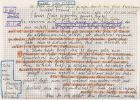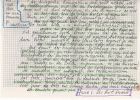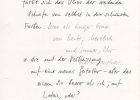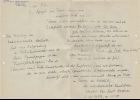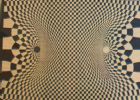Vilém Flusser
Articles of Vilém Flusser
Bibliophagus convictus / Bibliophagus / Bibliophagus
In this satirical fable, Flusser mocks among other things the growing importance of recycling and the recycling of that which has already been recycled, of plagiarism, the lack of originality and true creativity in the production of books, and the tsunami like character of book publications typical of present-day culture. This phenomenon extends to all other areas of cultural production and consumption. The Bibliophagus is a hybrid insect that lives in hives like bees and feeds only on printed alphanumeric texts that it consumes in paragraphs. It chews them with the help of an acid called “criticasis” that turns into “informasis” when if fuses with the printing ink. This morsel passes through the mouths of all other Bibliophagi who each swallow a small bit of the morsel which is then carried by a “mediator” to all other hives. Soon everyone is duly informed, and the new information leads to a genetic mutation of the species. However, any redundancy in the chewed and swallowed text morsels leads to a cancerous growth that affects each single Bibliophagus and their species as a whole. For this reason, the species has an interest in the generation of texts that do not contain redundancies. In order to survive it must intervene in the process of generating texts. In the brain of a deceased writer, one discovers a Bibliophagus that is still alive. The writer who had the insect placed inside his brain via a trepanation had died of an overdose of “informasis”. The trepanation has already assumed an epidemic character and spread all over the world. The earlier longer Portuguese and English versions “Bibliophagus” are written from the subjective point of view of the writer narrating how he met the insect , whereas the much shorter German variant “Bibliophagus convictus” makes use of a more distanced third person point of view. A corresponding English version has already been published in Flusser Studies 13. The imaginary creature of the Bibliophagus convictus is foreshadowed in Flusser’s “Bichos Series (I-V)” that has also been published in this issue.
Bichos I-V / Beasts I-V / Tiere I-V
In the short series Beast I-V published in the column “Posto Zero” of the Brazilian newspaper Folha de São Paulo from March 22 to March 28, 1972, Flusser uses animals to discuss such diverse subjects as science fiction, logic, alien life, post-humanism, and anthropocentrism. These early texts anticipate the imaginary creature of the Bibliophagus convictus. The first text, “Ants,” deals with human loneliness on Earth and our attempt to communicate with other beings in the universe, as well as our inability to communicate with the species on our own planet. The central idea in “Chimps” is that a chimpanzee caged in a zoo could be seen as both an image of our animal past and of our post-human future. The third, “Unicorns”, discusses the incapacity of logic to deal with an imaginary animal like the unicorn, even though it needs it to exemplify the notion that something is without any sense. In the fourth, “The Seven-Headed Beast,” Flusser proposes that science fiction adopts a strategy that pursues the unlikely, yet possible. The final text, “People,” deals with anthropocentrism arguing that we only see ourselves as different from other animals because we separate anthropology from zoology. For Flusser, each species is a culminating point in evolution, even though each one belongs to a branch that has a different goal. This idea foreshadows the book Vampyroteuthis infernalis that was published fifteen years later.
Angenommen (Vermutung, jetzt!) /Angenommen – Kurz und gut / Now suppose / Angenommen. Einleitende Bedenken / Angenommen. Einleitung / Suppose that. Preliminary doubts / Suponhamos. Dùvidas preliminaries /Suppose that. Introductory considerations / ...
The first text published here, “Angenommen (Vermutung jetzt!)”, is a German translation of “Now suppose” with an introductory comment by William Hanff. It is possibly one of the seeds from which the other texts we are publishing here originated and at the same time the initial spark for the idea of a special issue about Flusser’s book Angenommen. The Portuguese and the English versions of Angenommen, which consist only of nine scenarios, were not finished. On the other hand, Flusser wrote two German versions, a first incomplete one and a second one with the final twenty-two scenarios. In preparation for the book edition of Angenommen, Flusser wrote several short essays and opening chapters in German, English, and Portuguese, constantly changing the title, the subtitle, and the content. Some of these texts bear an epigraph by Isaac Newton – “Hypotheses non fingo” – some do not. This quote was later included in the first German edition of the book published in 1989. The first two essays of this series are probably “Angenommen” and “Now suppose”. They are longer than most of the following texts and have the same beginning. However, the English version, that is slightly shorter and was most probably written after the German one, introduces on the second page the notion of an armed terrorist running towards the future. In the following versions, this image was moved to the beginning. Two more German versions, “Angenommen. Einleitung” and “Angenommen. Einleitende Bedenken” followed, along with two related English versions, “Suppose that. Preliminary doubts” and “Suppose that. Introductory considerations”, as well as a Portuguese variant, “Suponhamos. Dùvidas preliminaries”. Add to this the short essay “What if? A series of scenarios in search of images” and two other related texts “Randerscheinungen” and “Kurz und gut” which was published in “zeitmitschrift. Journal für Ästhetik & Politik” (7/1, 1990: 16–22). A polyglot parallel reading of all the different variants of the opening chapter and the other related texts that finally led to the publication of Angenommen in 1989 allows a fascinating insight into the hesitations and complexities of Flusser’s self-translating writing process.
Reflexões sobre “A Casa da Cor à construir em S. Paulo” / Casa da Cor, (reflexões complementares) / Mesa redonda / A cor no mundo pos-moderno / Codigo de cores / Video palestra / Casa da Cor, S. Paulo / In search of a colour code / Why the house of ...
In the two years (1987-1989) in which Flusser collaborated in the project of the Casa da Cor he wrote a series of texts, held conferences, and made several video interviews that have been transcribed. Flusser discussed the House of colour from two distinct but complementary and converging perspectives: the new house to be built and the necessity of a new colour code. In the mid-1980s, Flusser formulated the notion of an all-encompassing convergence of cultural and technical codes. In the context of the project of the House of Colour, he reformulated this vision including colour.
Um alfabeto de azuis e amarelos
In the interview “Um alfabeto de azuis e amarelos” (An alphabet of blues and yellows) published by the magazine “Superinteressante” in November 1988, Flusser discussed his theoretical position. The problem with spoken and written languages is that they are inadequate to describe the world, which could be described much better in mathematical terms. However, the problem with numbers is that they are separated from each other by intervals. Colours, on the other hand, tend to blend into each other.
Letters / Postmoderne Farben
Although Flusser met Gottfried Jäger in 1984, the dialogue between them began with a short letter from Flusser to Jäger on March 4, 1988, presenting the project of the Casa da Cor. The letter is accompanied by the essay „Postmoderne Farben” which Flusser dedicated to Jäger, possibly to lure him into a collaboration. Jäger held a speech on autonomous colour on the second day of the 1989 conference (August 23) in São Paulo.
Letters / Farben statt Formen / Coloration replacing formalisation / Farben verschlüsseln / Karl Gerstner / Vilém Flusser und die Farben
Vilém Flusser and Karl Gerstner got to know each other in February 1987 at the 2nd Latin American Seminar on Alternatives for the teaching of the history of science and technology. Their letter exchange covers a period of about two years (1987-1989). Flusser and Gerstner were united by an intellectual and emotional friendship, read each other’s works, and dedicated a very personal text to one another: “Karl Gerstner” and “Vilém Flusser und die Farben” published in 1992 after Flusser‘s death. Flusser wrote two other texts “Farben verschlüsseln“ and “Farben statt Formen“, together with its English version „Coloration replacing formalisation“ in early 1988, as a discussion proposal for Gerstner. He dedicated “Farben verschlüsseln“ to Gerstner and sent the text with a letter, dated March 4, 1988. While Flusser wrote all his texts with a typewriter, Gerstner’s letters are practically all handwritten and in some cases in colour. To emphasize this difference the letters have been published separately and in different formats: Flusser’s letters are PDF-files and Gerstner’s JPEG and JPG-files.
L’irruption du téchno-imaginaire / A. Bonnier Cor de Rosa / O negro será de cor? / Preto e branco / O preto é belo / Schwarz ist schön / Ecologia multicolorida? / Vom Umfärben der Grünen / Bunte Tiere / Disney Land Colors
This selection of texts, which date from the early 1970s to the late 1980s, documents Flusser’s interest in colour over nearly twenty years. Besides the connection of black and white in photography and discourses on “racial” differences, the role of greyness and its relationship to colour luminosity in the description of culture and politics, the presence of colour in nature, landscape, and the animal world, Flusser also used colour to redefine the notion of technical image.
Reflexion. Henry Lewis: X-Räume / Reflexion. Henry Lewis: X-spaces / Henry Lewis, X-Spaces
In 1990, “European Photography” published a text by Vilém Flusser on the work of the photographer Henry Lewis: „Henry Lewis: X-Spaces (41/11, 1990: 46-47). In this essay, Flusser discusses the impossibility to experience space with the eyes. We can only reach as far as the surface of objects, he writes, but radiography penetrates beyond the surface into space. Flusser contends that Henry Lewis is not interested in finding out what is behind the surface, but in making the experience of space visible. He is making pictures of the third dimension.
Jogos / Spiele / Games
In this essay, Flusser identifies human beings as homo ludens, the playing animal, asserting that the capacity to play is their defining feature. He notes at the outset that it is no longer the difference between humans and animals that is at issue, but a difference between humans and their apparatuses. In supporting his claim, he defines a game as system of elements that regularly combine, then goes on to describe categories of games within which the whole of human communication can be aligned. He focusses on three examples -- chess, language (he chooses Portuguese), and science, using them to introduce terms, e.g. “elements,” “competence,” “repertoire” and “universe,” that apply to games in general but also facilitate comparison and contrast. Above all, he underscores the need for human beings to be aware of the games in which they participate, for only in such an awareness is it possible to actually play a game -- that is, expand and change it, create something new -- as opposed to being played by it, caught in the operations of a fixed, stolid, apparatus. First published in German in 1968, the text introduces terms that Flusser developed further in subsequent writings.
